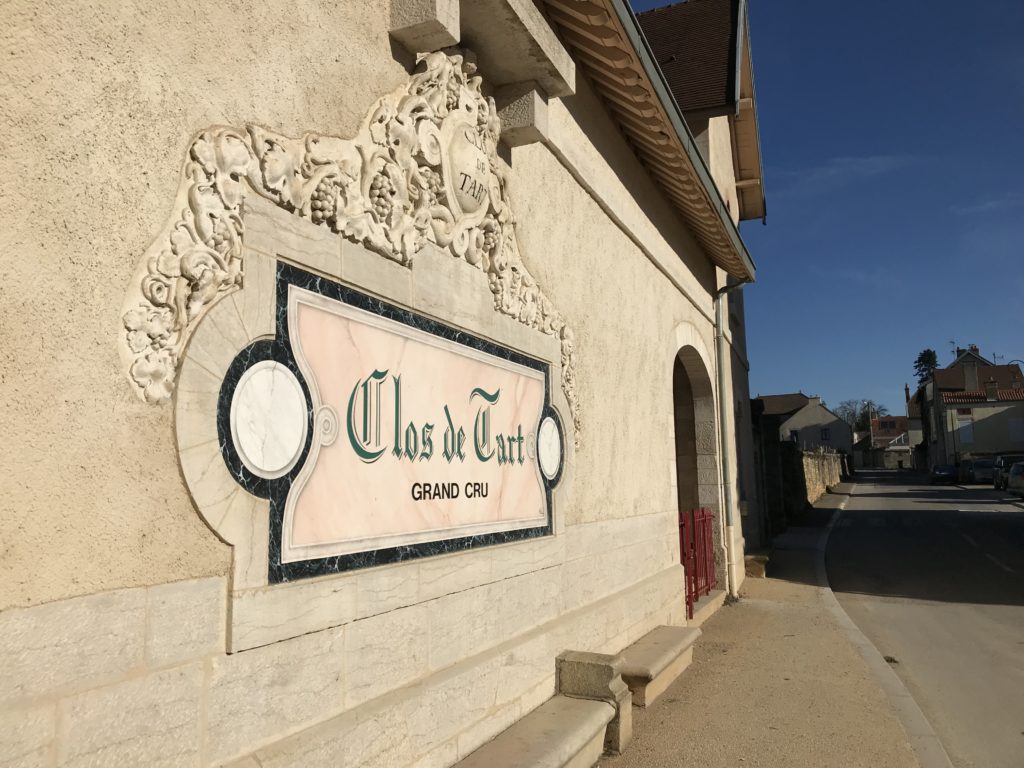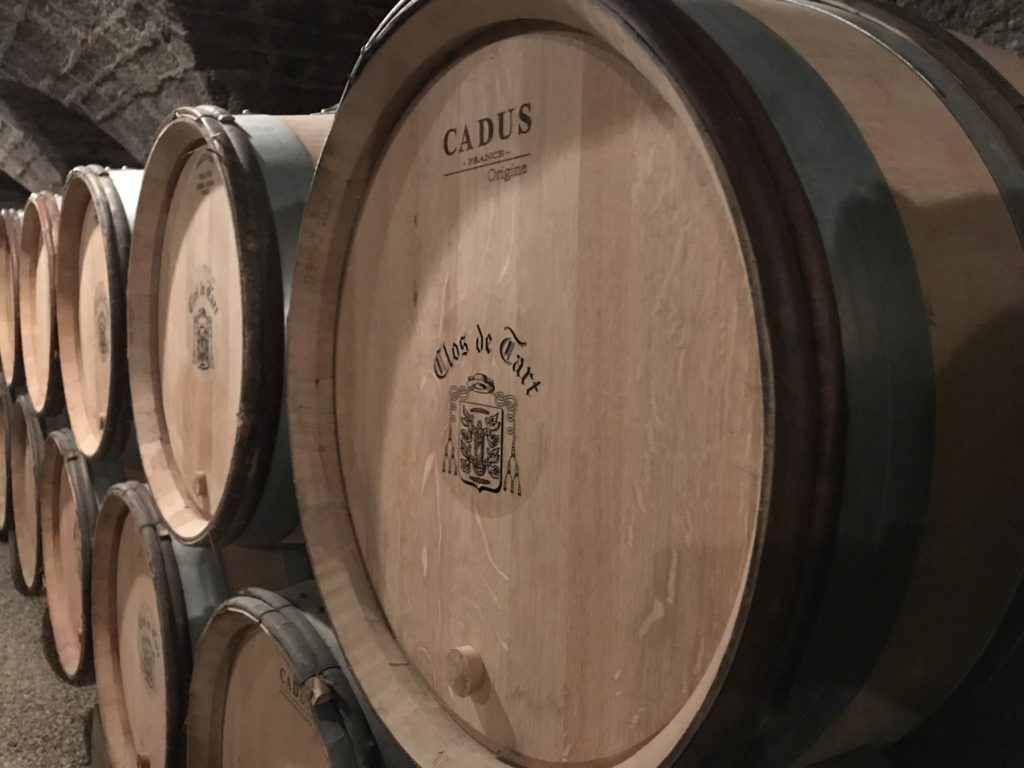Alessandro Noli, previously of Château Grillet, became the new Régisseur of Clos de Tart in March 2019.
Clos de Tart and Château Grillet are two of only seven grands crus monopoles in France. There the similarities end, however: Alessandro has moved from the world of white wine to red, from Condrieu to Pinot Noir. This appointment follows the acquisition of the domaine in 2017 by François Pinault’s Groupe Artémis. The wine arm of this formidable operation, Artémis Domaines, counts among its holdings Château Latour, Domaine d’Eugénie and Château Grillet itself.
Alessandro replaces Jacques Devauges, whose brief but highly effective tenure – during which he made the phenomenal 2016 vintage – followed that of the legendary Sylvain Pitiot, Régisseur from 1996 to 2015.
Prior to 2017, the Clos had only changed hands twice since the 12th century. These sturdy stone walls will be unfazed though. The weight of history here has a momentum of its own and we can be sure that the vines will continue to work their magic.
In light of these changes, we continue to be proud that M. Pinault, through Managing Director Frédéric Engerer and Sales and Marketing Director Jean Garandeau, have renewed Corney & Barrow’s exclusive representation of the domaine in the UK. Having represented Clos de Tart since the 2007 vintage, this release marks the start of our second decade.
History
Clos de Tart was confiscated from the Church following the 1789 French Revolution, then acquired uncontested at auction by local wine merchant Nicolas-Joseph Marey.
At the same auction Marey, whose family would later become Marey-Monge, bought the entire Romanée-Saint-Vivant vineyard (their name appears on the label of Domaine de la Romanée-Conti’s RSV to this day).
Originally called La Forge, the vineyard was acquired in 1141 by the nuns of Nôtre-Dame de Tart. The perimeter wall was likely built in the 15th century. The second change in ownership took place during the depression of the 1930s. In 1932, the Marey-Monge family sold Clos de Tart to the Mommessin family, for 400,000 francs at auction. The Mommessins ran a successful négociant house in Mâcon, which was eventually sold to Boisset in the 1990s.
The Birth of a Grand Cru
Jules Lavalle’s Plan Topographique of the Côte d’Or was published in 1855 and became a reference point for the classification of the region’s vineyards 80 years later. It singled out one Tête de Cuvée vineyard in Morey-Saint- Denis: Clos de Tart.
Following the establishment of the appellation contrôlée system in 1936, Clos de Tart was named in the grand cru decree of 1939, at which point the brick wall was extended to include some adjoining vines.
In 1965-6, an additional 0.278 hectares was added from Bonnes-Mares: vines which, despite being in Chambolle- Musigny, were within the walls of the Clos. There are definite similarities between the two vineyards, with some arguing that Bonnes-Mares is ‘more Morey than Chambolle.’

The Vineyard
The brilliant white limestone walls of the domaine dominate the Place de l’Église in Morey-Saint-Denis. Behind them lie the 7.53 hectares of Clos de Tart.
Clos de Tart is one of five grands crus in Morey-Saint-Denis and, being in sole ownership, its only grand cru monopole. The gently sloping vineyard faces east, making it something of an anomaly in the village. The vines run north-south, perpendicular to the slope rather than up and down. As well as giving a unique sun exposure, this protects against erosion. Although this is one contiguous vineyard, the soil composition is sufficiently intricate to vinify eight separate cuvées, from no fewer than 27 different plots. These are blended around a month before bottling. The clay-limestone soils come from three distinct geological eras.
The first soil type is calcaires à entroques, loose limestone-rich fossilised marine animals. Second is white marl, a deep layer of which runs through the mid-slope section. Finally, there is a layer of very hard, compacted Prémeaux limestone. The cuvées change every year, but there is some correlation with these soil types. The map opposite shows the origin of each of the 2017 cuvées. The average vine age is over 60 years, with some plots containing vines of up to 100 years. The domaine has a nursery which provides new vines when replanting is necessary.
Planting density is high: 11,000 vines per hectare on average, with the younger vines having been planted at 12,500. The resulting competition for nutrients encourages the roots to dig deeper. Only the five best bunches per vine are retained during green harvesting in August. The Clos has practised organic viticulture since 2015, with certification received in 2018, ahead of biodynamic certification, which is expected in 2020.
Production tends to be 23 to 30 hectolitres per hectare (hl/ha), although in 2016, it was 35 hl/ha, the domaine’s largest crop since 1999 and in 2017 was a similarly respectable 32 hl/ha.
The Cellar
The domaine is currently undertaking a complete renovation of the cuverie.
Once completed, in time for the 2019 vintage, this will contain 15 wooden vats, made by Taransaud and five stainless steel tanks. Fermentation will take place in the wooden vats, with the tanks used for blending and settling. Compared to the domaine’s intricately analytical approach to viticulture, the winemaking process is rather simple. Fermentation is carried out by natural yeasts. Some whole bunches are used, with the proportion varying in accordance with the vintage conditions – 60% in 2017.
The grapes receive one week of pre-fermentation maceration, with fermentation taking another week, and a further week of post-fermentation maceration. Extraction is very gentle. Both pigeage (punching-down) and remontage (pumping-over) are used sparingly to aerate the
grape must and extract phenolic content. The individual cuvées are aged separately for 19 months in oak, typically 80% new, with the remaining 20% being one year old. The majority of the wine is aged in 228 litre French oak barrels, although larger oak vessels have been introduced in recent years. Blending takes place one month before bottling, which is still done by hand.

2017 Growing Season at Clos de Tart
“The superb grapes of the 2017 harvest form part of a series of early Burgundy vintages, which started in 2003.”
Jacques Devauges, Regisseur, Clos de Tart, 2014-2019
By contrast to the cold winter, March was the warmest since 1957. Under these conditions, bud-burst took place extremely early, starting on the 30th March. On the morning of 20th April, catastrophe was narrowly avoided: the temperature plunged to -1.5˚C, but thanks to low levels of humidity and windy conditions, the Clos avoided the dreaded frost. With spring appearing more like summer, vineyard growth proceeded extremely quickly, keeping the team on their toes. Flowering started on 2nd June. After a glorious summer, harvest started on 6th September,
finishing on the 10th. The berries were irreproachably healthy, aromatic and with very thick skins. Yields were, for once, in line with target, coming in at 32 hectolitres perhectare.
Vinification took place without complications. Forge de Tart was entirely destemmed, with Clos de Tart itself being 60% whole-bunch vinified. The wines will be bottled in spring 2019.

